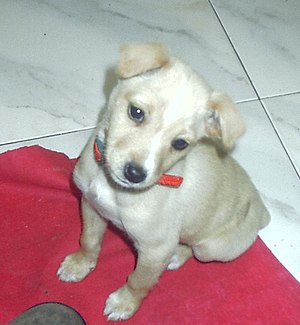 |
| puppy (Photo credit: Wikipedia) |
Puppy Training Essentials
A cute puppy can melt anyone's heart. If you're thinking
about getting a puppy, or already have one, congratulations. Training is
essential to having a good relationship with your pup. You'll feel more
confident, if you're home with them or not. Continue reading to gain great
insights into developing a strong bond with your pet.
Puppies have their own personalities and you need to find
the ideal training method for your puppy. For instance, a loving and laid back
puppy will do well when positive reinforcement is administered. On the other
hand, an aggressive puppy may respond well to negative reinforcement. If you are
failing with your method, try something new.
Do not allow your pooch to be in charge of the leash. You
lead the puppy, he does not lead you. Use the correct tools, such as a harness
and leash, and keep him at your heel or stop walking completely when he pulls.
Don't forget that you are the boss.
Patience and puppies go hand-in-hand. Puppies aren't human
and they don't speak English. He will pick up physical gestures, and this is
how he will learn from you. Stay calm and take breaks during training to ensure
it stays positive.
When training your pet, it is crucial that you have everyone
in your family involved in order to make the training consistent. Make sure
that all household trainers are using the same commands and treats. Consistency
is imperative in puppy training.
When starting to train a puppy, make verbal cues that let
the animal know the exact time when they correctly carry out a command.
"Yes" is the perfect word to show puppies approval before giving a
treat.
Stay firm when you are training your puppy. You should not
be yelling at your puppy all the time. Be strict only when your puppy disobeys
or adopts an attitude you do not approve of. This way you will develop a strong
bond with your puppy.
When puppy training, be sure that your puppy's leash has
some slack in it. This gives your puppy the option to explore and walk around
freely. Since they will be so eager, they may try to pull too hard, straining
the leash. The smart owner will deter this behavior by having his pet walk
without tension on the leash.
Training a puppy is a never-ending process. Before you feed,
pet or take your puppy outside, have your puppy first sit. Doing this will help
reinforce what your puppy has learned and will show them that they need to
behave in a variety of situations. Otherwise, your puppy may only sit when you
are in the same conditions as the training session.
Do you notice your puppy often pulling on his leash? Many
puppy owners have this complaint, but it's also quite simple to rectify. Buy
yourself a puppy harness, which will reduce pulling and improve the quality of
your walks.
To make sure your puppy's behavior stays good, you should
continue training him throughout its life. A puppy does not stop learning after
puppyhood. Reinforce the positive behaviors, reward your puppy for being
obedient and punish your puppy for its bad behavior.
If your puppy has an issue with barking, pay attention to
potential triggers. When you understand the antecedent, you can manage the
behavior correctly. For instance, if the only time your puppy barks too much is
when visitors arrive, ask a friend to visit you to assist you in dealing with
the behavior when the trigger event occurs.
When teaching your puppy how to fetch, show him that you're
the leader by teaching him to bring you the ball at all times. Your puppy will
begin to think it is the leader if it can drop the ball and make you go and
pick it up. Teaching the puppy that he must bring the ball to you each time
helps your puppy to understand what is wanted of him at all times with the
ball.
Use a bell to train your puppy to go outside to pee. In the
beginning, you will jingle the bell to signal it's time to go outside.
Eventually, your puppy will pick up on this to tell you when he needs to go
out. Puppies are intelligent and attentive, and by consistently using this
technique, they will connect the dots and ring the bell to request to go out.
Primary reinforcement is critical to puppy training. In this
method the reward you use is something it is natural for your puppy to want.
You can use food or a nice belly rubs as primary reinforcements. The best
rewards are things your puppy already likes and wants.
As this article has shown, there are many effective ways to
train your puppy. Learn the above techniques and begin using them today. Your
heart no doubt already belongs to your puppy. Training is the key to success!
It is important that your puppy be well trained. Congratulations on being a pet
owner.

No comments:
Post a Comment